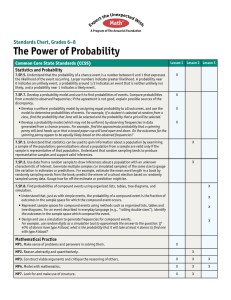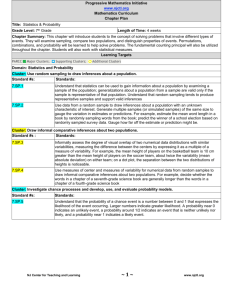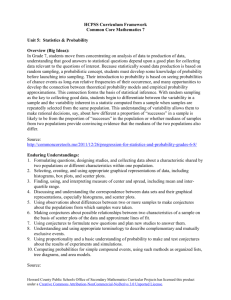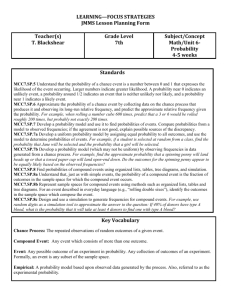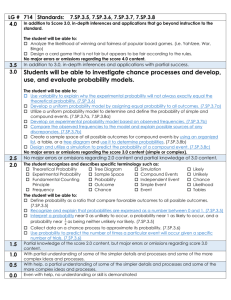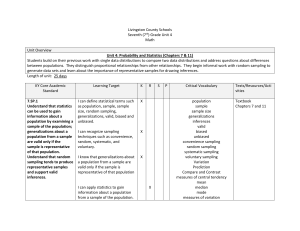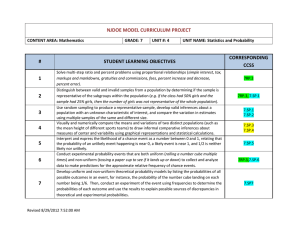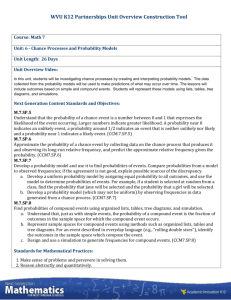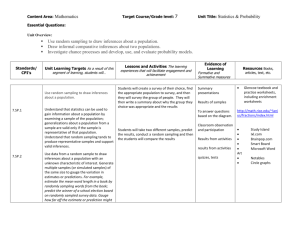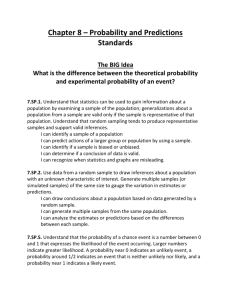Math4.7.SPupdated
advertisement
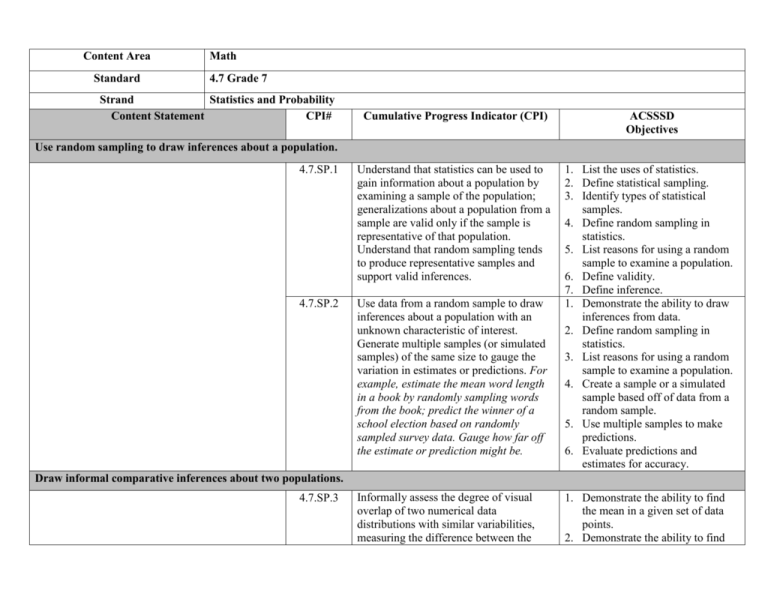
Content Area Standard Math 4.7 Grade 7 Strand Statistics and Probability Content Statement CPI# Cumulative Progress Indicator (CPI) ACSSSD Objectives 4.7.SP.1 Understand that statistics can be used to gain information about a population by examining a sample of the population; generalizations about a population from a sample are valid only if the sample is representative of that population. Understand that random sampling tends to produce representative samples and support valid inferences. 4.7.SP.2 Use data from a random sample to draw inferences about a population with an unknown characteristic of interest. Generate multiple samples (or simulated samples) of the same size to gauge the variation in estimates or predictions. For example, estimate the mean word length in a book by randomly sampling words from the book; predict the winner of a school election based on randomly sampled survey data. Gauge how far off the estimate or prediction might be. 1. List the uses of statistics. 2. Define statistical sampling. 3. Identify types of statistical samples. 4. Define random sampling in statistics. 5. List reasons for using a random sample to examine a population. 6. Define validity. 7. Define inference. 1. Demonstrate the ability to draw inferences from data. 2. Define random sampling in statistics. 3. List reasons for using a random sample to examine a population. 4. Create a sample or a simulated sample based off of data from a random sample. 5. Use multiple samples to make predictions. 6. Evaluate predictions and estimates for accuracy. Use random sampling to draw inferences about a population. Draw informal comparative inferences about two populations. 4.7.SP.3 Informally assess the degree of visual overlap of two numerical data distributions with similar variabilities, measuring the difference between the 1. Demonstrate the ability to find the mean in a given set of data points. 2. Demonstrate the ability to find centers by expressing it as a multiple of a measure of variability. For example, the mean height of players on the basketball team is 10 cm greater than the mean height of players on the soccer team, about twice the variability (mean absolute deviation) on either team; on a dot plot, the separation between the two distributions of heights is noticeable. 4.7.SP.4 the distance of each data point from the mean. 3. Demonstrate the ability to find the mean absolute deviation of a data set by finding the mean of the distances of the data points from the mean. 4. Demonstrate the ability to read and create dot plots. Use measures of center and measures of 1. Demonstrate the ability to find variability for numerical data from the measures of central tendency random samples to draw informal (mean, median and mode) of a comparative inferences about two given data set. populations. For example, decide whether 2. Demonstrate the ability to find the words in a chapter of a seventh-grade the measures of variability science book are generally longer than the (range, interquartile range and words in a chapter of a fourth-grade mean absolute deviation) of a science book. given data set. Investigate chance processes and develop, use, and evaluate probability models. 4.7.SP.5 Understand that the probability of a chance event is a number between 0 and 1 that expresses the likelihood of the event occurring. Larger numbers indicate greater likelihood. A probability near 0 indicates an unlikely event, a probability around 1/2 indicates an event that is neither unlikely nor likely, and a probability near 1 indicates a likely event. 1. Define probability. 2. Demonstrate an understanding that probability ranges from 0 to 1. 3. Recognize that a probability closer to 1 indicates that an event is more likely to occur. 4. Recognize that a probability closer to 0 indicates that an event is less likely to occur. 5. Recognize that a probability around ½ indicates that an event is neither unlikely nor likely to occur. 6. Recognize that if an event is a certainty, then the probability is 4.7.SP.6 4.7.SP.7 a. b. 1. 7. Recognize that if an event is impossible, then the probability is 0. Approximate the probability of a chance 1. Find the experimental probability event by collecting data on the chance of a chance event. process that produces it and observing its 2. Demonstrate the ability to long-run relative frequency, and predict approximate probabilities. the approximate relative frequency given 3. Demonstrate the ability to collect the probability. For example, when data. rolling a number cube 600 times, predict 4. Define long-run relative that a 3 or 6 would be rolled roughly 200 frequency. times, but probably not exactly 200 times. 5. Given data from experimental probability, make a prediction. 6. Make a prediction based on theoretical probability. 7. Compare experimental and theoretical probabilities. Develop a probability model and use it to find probabilities of events. Compare probabilities from a model to observed frequencies; if the agreement is not good, explain possible sources of the discrepancy. Develop a uniform probability model by 1. Define uniform probability assigning equal probability to all model. outcomes, and use the model to determine 2. Demonstrate an understanding of probabilities of events. For example, if a equal probability. student is selected at random from a 3. Complete a chart to find class, find the probability that Jane will experimental probability. be selected and the probability that a girl 4. Create a uniform probability will be selected. model. 5. Use a model to determine probability. 6. Identify independent outcomes in probability. Develop a probability model (which may 1. Define probability model. not be uniform) by observing frequencies 2. Distinguish between a in data generated from a chance process. probability model and a uniform For example, find the approximate probability model. probability that a spinning penny will land heads up or that a tossed paper cup will land open-end down. Do the outcomes for the spinning penny appear to be equally likely based on the observed frequencies? 4.7.SP.8 3. Determine if a situation has equal probability or unequal probability. 4. Create a probability model. 5. Demonstrate the ability to make observations from data. 6. Identify situations that would cause biased results or random results. Find probabilities of compound events using organized lists, tables, tree diagrams, and simulation. a. Understand that, just as with simple events, the probability of a compound event is the fraction of outcomes in the sample space for which the compound event occurs. b. Represent sample spaces for compound events using methods such as organized lists, tables and tree diagrams. For an event described in everyday language (e.g., “rolling double sixes”), identify the outcomes in the sample space which compose the event. 1. Demonstrate the ability to create a table that displays possible outcomes of a compound event. 2. Demonstrate the ability to count possible outcomes of a compound event displayed in a table. 3. Demonstrate the ability to express the probability of a compound event as a fraction where the possible outcome described is represented by the numerator and the total of all possible outcomes is represented by the denominator. 1. Demonstrate the ability to create an organized list that displays possible outcomes of a compound event. 2. Demonstrate the ability to create a table that displays possible outcomes of a compound event. 3. Demonstrate the ability to create a tree diagram that displays possible outcomes of a compound event. c. Design and use a simulation to generate frequencies for compound events. For example, use random digits as a simulation tool to approximate the answer to the question: If 40% of donors have type A blood, what is the probability that it will take at least 4 donors to find one with type A blood? 1. Refer to the ACSSSD Objectives of 4.7.SP.8.ba and 4.7.SP.8.b for the prerequisite skills needed to complete this CPI. 2. Demonstrate the ability to use multiple means (coin toss, die roll, color wheel or computer) to generate random numbers for data set. 3. Demonstrate the ability to assign random numbers generated to each of possible outcomes in a simulation. 4. Demonstrate the ability to record outcomes of simulation in a table. 5. Demonstrate the ability to express the experimental probability of a simulation as a fraction where the possible outcome described is represented by the numerator and the total of all possible outcomes generated is represented by the denominator.
